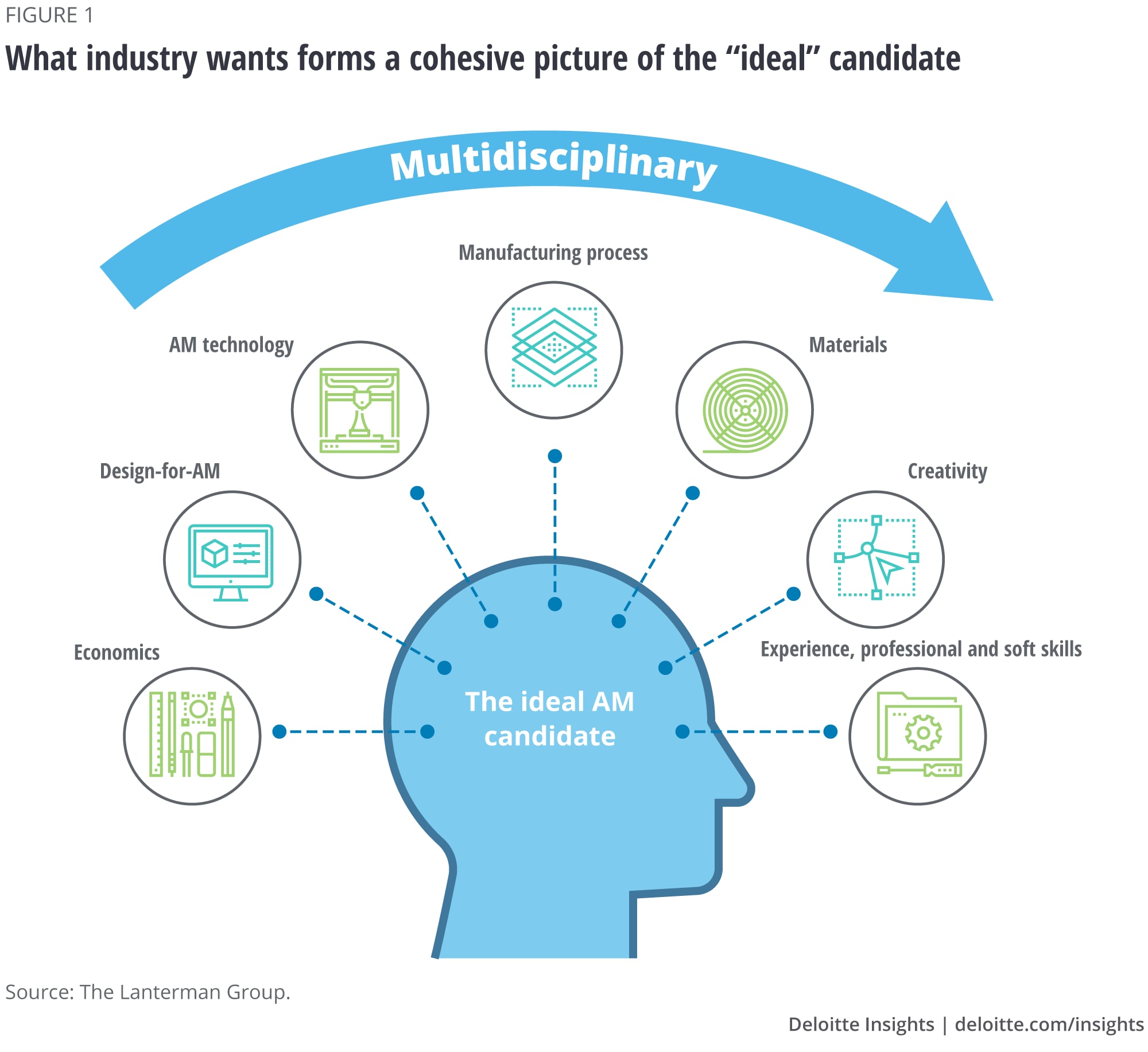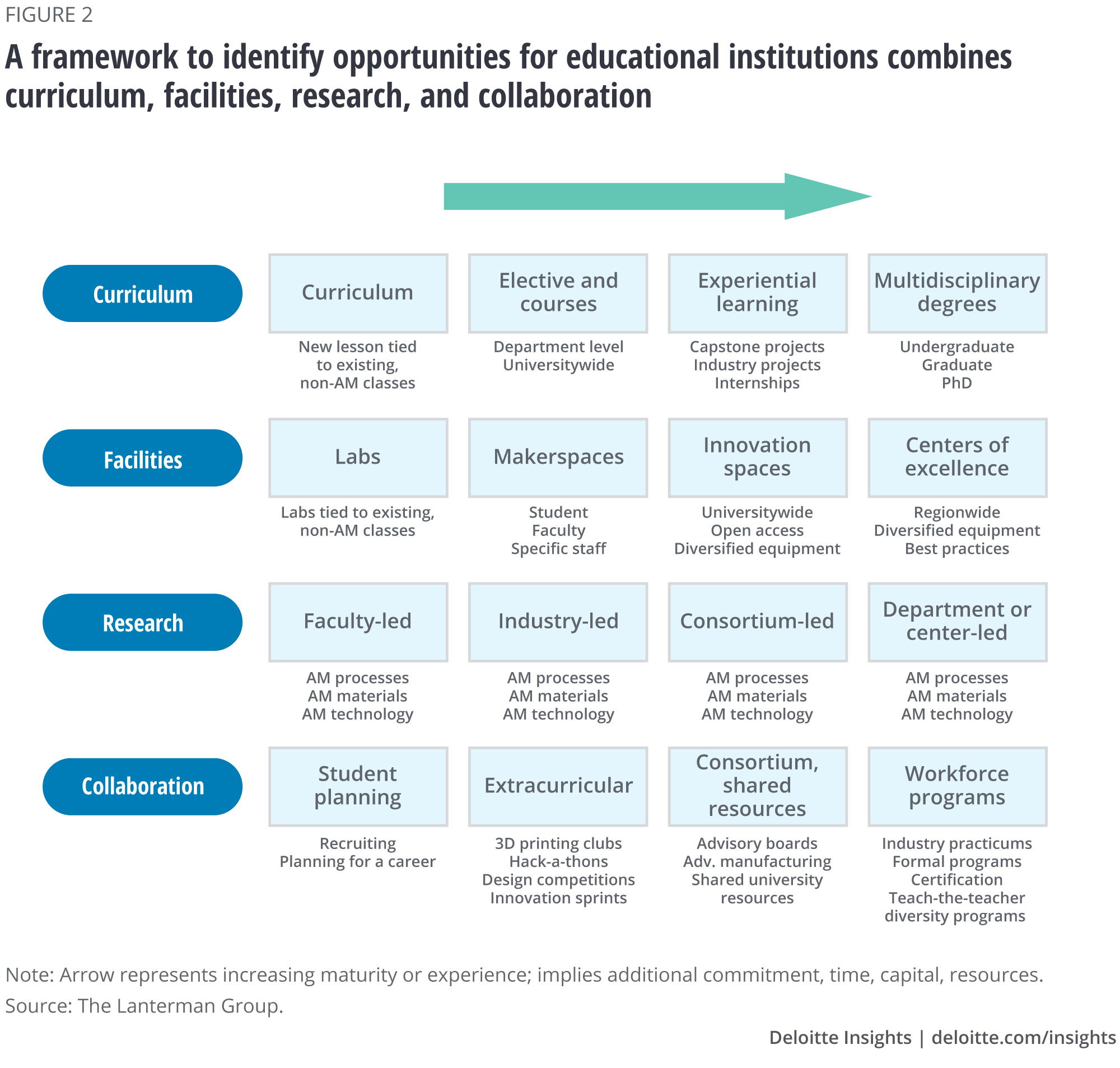
3D opportunity for higher education Preparing the next generation of additive manufacturing professionals
17 minute read
02 April 2019
 Mark Cotteleer United States
Mark Cotteleer United States Anthony Hughes United States
Anthony Hughes United States Gina Scala United States
Gina Scala United States Jonathan Holdowsky United States
Jonathan Holdowsky United States
Additive manufacturing is slowly but surely transforming product design and manufacturing. But to realize its true potential, industry and academia need to work together to develop and train the next generation of additive manufacturing talent.
Introduction
Additive manufacturing (AM) is revolutionizing the way many products are designed and manufactured. However, unless manufacturers can effectively scale this new technology into production uses, the real promise of AM may not be fulfilled. One of the challenges often identified as limiting AM’s scale is the lack of a capable and skilled AM workforce.1
Learn More
Explore the 3D opportunity collection
Visit the Higher education collection
Explore Industry 4.0
Subscribe to receive related content from Deloitte Insights
To better understand the landscape of issues, challenges, and opportunities that form the basis of achieving a highly capable AM workforce, we conducted research with some of those who perhaps have the most at stake. This report—the output of interviews with academic institutions, and industry experts, and supplemented by secondary research (for more details, see the “Methodology” sidebar)—argues that the unlocking of AM’s potential resides in educating a broader workforce, and that the opportunity for industry and academia to work together to educate the next generation of AM talent is at once real and significant.
Methodology
The purpose of this report was to gain an understanding of the issues and opportunities that both industry and academia face in shaping the next generation of AM professionals. This report is the end result of our primary and secondary research efforts. In carrying out our primary research, we conducted 11 interviews with academic institutions and seven interviews with industry experts. Our academic interviews involved institutions with substantial coverage in addressing AM-related issues, particularly around talent shortfalls. Our industry expert interviews involved professionals from a variety of company sizes and industries—all with an active interest in AM-related workforce initiatives. We supplemented our primary research with extensive secondary literature reviews.
The promise of AM: Functional production applications
Over the last several years, the use of AM has slowly shifted from a purely rapid prototyping solution to a production-worthy manufacturing technology.2 While AM’s use in directly printing components is still maturing, its long-term appeal—that it can be used to more effectively and efficiently produce functional parts and products for the industrial manufacturing sector—is why most companies continue to invest in it.3
In 2017, for example, nearly a billion dollars were spent on AM for end-use production parts, approximately a one-third increase from the previous year.4 Just five years prior to this, in 2011, this number was estimated to be around US$246 million.5
Workforce skill is tempering adoption
Executives with whom we spoke stated that they, too, are aggressively ramping up efforts to leverage AM’s potential in production settings, and to further integrate it into their existing manufacturing operations. However, they also stated that they are continuing to invest in it even though much of today’s workforce lacks the advanced skills and deep knowledge necessary to transition product innovations off the drawing board and into production. More notable is their belief that unlocking AM’s production potential requires a much different skill set from just an understanding of how to run a machine or rapidly produce a prototype. Rather, to accelerate AM’s adoption rate, industry may need a broader workforce with knowledge of the capabilities of AM technologies and how to appropriately design, communicate, and qualify products.6
Our research identified actions that many educational institutions are taking to address the AM skills gap and supply a capable and competent workforce. While there are several academic bright spots, there is room for improvement to broaden the availability and depth of AM courses and curricula, as most current training programs do not deliver the necessary skills and knowledge required for successful AM deployment. Additionally, AM is not often integrated into existing design and engineering curricula and very few institutions have specialized AM programs.7
A call to action
Based on our interviews, one priority seemed to rise above all others: Industry should partner with academia (post-secondary education, trade schools, universities) in closing the knowledge gap around commercializing AM technologies. This means not just developing AM specialists, but also inculcating a better understanding of what AM is and its potential applications to benefit the larger technical workforce where AM may play some role, but is not necessarily an area of focus.8
Broader advancement starts with a new AM mindset: What industry wants
At a high level, our research revealed that commercializing products and scaling AM into the production setting typically requires knowledge in two distinct areas:
- Design knowledge necessary to innovate and develop the AM product (i.e., product design, engineering, simulation, etc.)
- Process knowledge required to manufacture the AM product (i.e., process and material selection, operations, quality, inspection, etc.)
The good news is that industry does seem to recognize academia for its effort and role in advancing the much-needed process knowledge, by educating the highly specialized technical production workforce and for creating interest in AM within the existing student population. They noted that the education system has done a generally good job in getting students interested in the technology and providing a baseline of knowledge about its capabilities. Moreover, technical and community colleges seem to have adapted curricula to meet the current demand for skilled operators and technicians.
That in mind, industry leaders continue to seek a workforce with broader knowledge across both the design and manufacturing disciplines to help innovate and optimize new products for the efficient use of AM technologies. AM’s promise in the production setting is often predicated on the adaptation of existing products or on the clean-sheet creation of new ones.9 Industry interviewees noted that the greatest unlock for AM is also its greatest challenge—developing innovative products optimized for AM—and finding a workforce equipped with the design sensibilities to accomplish this is still challenging.
Toward that end, the industry leaders and academics that we interviewed agreed that a new mindset might be required to unleash the full potential AM offers as a suitable production alternative. What’s missing from today’s workforce?
Below are five key workforce education “needs” highlighted by industry participants:
- A multidisciplinary understanding of key AM-related knowledge areas—material science, design, engineering, etc.
- Better design knowledge, specifically design-for-AM (“DfAM”) skills
- A broader, more creative, and innovative mindset
- A better understanding of AM’s ties to existing manufacturing processes, not just AM
- A commercial mindset to understand the AM business case
In the next few pages, we explore each of these items in detail.
Developing a multidisciplinary learner and professional
Successful AM deployment is expected to require teams to work across multiple disciplines such as engineering, design, material science, and manufacturing. These diverse subject areas can make closing the AM skills gap a deeper, more complex problem that cannot be overcome with just a single focused technical degree.10
The industry interviewees desired a workforce that could more easily cross these disciplinary boundaries. “It’s extremely unusual to find graduates who have been exposed to or understand all the aspects of AM,” one interviewee stated. There was also concern about the “superficial” training that teaches AM “without linkage made between additive manufacturing process, materials, machines, and part quality [and without] integration of diverse disciplines, including advanced concepts such as materials, process, design simulation, reverse engineering, and others needed to unlock the value of additive manufacturing.”11 As one industry insider bluntly stated, “We don’t need a typical CAD/AM design person. We need someone who can integrate the physics, software, material, and creative thinking knowledge around AM into a new product.”
As one industry insider bluntly stated, “We don’t need a typical CAD/AM design person. We need someone who can integrate the physics, software, material, and creative thinking knowledge around AM into a new product.”
What clearly emerged is the consensus that simply knowing how to operate a machine isn’t, in itself, sufficient to maximize AM’s potential. To establish an efficient AM production process, engineers also should understand how to design for the AM process, what materials can be used, and how to use them. Without this integrated knowledge emanating from the full range of disciplines, it will likely become difficult to innovate AM production processes.12 Learners who can cross these multidisciplinary should become constituents of, and ultimately, advocates for, a stronger AM design community.13
Design knowledge could be a key enabler
Among this full panoply of cross-disciplinary knowledge, our industry interviewees suggest that design, or more importantly design-for-AM (DfAM), could serve as a key differentiator for their employees, and as a value creator for their company. One executive perhaps summarized this best by stating, “Finding the right technical skills is still challenging but what we lack now are the skills required to design and manufacture entirely new products which have been optimized for AM.”
A DfAM process allows manufacturers to improve existing products by leveraging AM’s unique capabilities by assisting designers in exploboundaries ring previously unexplored regions of design spaces.14 With AM, manufacturers can construct organic shapes or produce parts with internal structures—which is typically either impossible or impractical with conventional manufacturing—to create products that reduce weight or part count. AM’s unique capabilities can also deliver improved product functionality and cost reduction.15
Industry experts with whom we spoke argued that although they still needed technical specialists (i.e., material science, operators, etc.), the larger demand was from the broader design and related engineering skill sets. As one practitioner stated, “For every one material scientist, I need 20 more designers, engineers, and other people knowledgeable about AM.”
As one practitioner stated, “For every one material scientist, I need 20 more designers, engineers, and other people knowledgeable about AM.”
Unlocking the AM opportunity through a creative mindset
Our research showed that many companies were ultimately seeking to use AM to create new solutions that leverage unique AM capabilities, such as light weighting and part consolidation. But because the design freedoms available under AM are immense,16 some interviewees noted that it’s been hard for some existing engineers to conceive new AM solutions. This may speak as much to a creative mindset—the ability to think “outside the box”—as much as it does to a particular set of design or process skills. One aerospace executive told us, “One creative engineer found an AM solution to a problem, when 1,000 classically trained ones couldn’t.” Another was even more blunt: “[We] had to kick the most experienced engineer off the team because for months he kept constraining the problem around conventional thought processes.”
The imperative of the creative mindset stems from the basic fact that AM requires a design approach and set of software/analytical tools, which are both different from and, perhaps, unfamiliar to some more traditionally trained engineers.17 Newer techniques such as generative design offer possibilities to aid engineering in extracting value from AM, but most students are just only now getting exposure to these techniques.18 Additionally, we heard from industry that processes that maximize AM for innovation within new product design are fairly absent in existing company product development methods.
Because of these limitations, many companies now seek engineers that think differently from the previous generation.19 Unequivocally, our interviewees stated that, beyond the foundational technical and design skills that are prerequisite, a creative mindset is just as important and identified it as a critical barrier to producing new innovative designs.
Unequivocally, our interviewees stated that, beyond the foundational technical and design skills that are prerequisite, a creative mindset is just as important and identified it as a critical barrier to producing new innovative designs.
Strong underpinning of foundational manufacturing knowledge
Industry leaders expressed a desire to have a workforce grounded in foundational, traditional manufacturing knowledge, as well as AM. “We don’t want additive manufacturing to be taught in a vacuum,” stated one interviewee. Having this foundational manufacturing knowledge, in addition to knowledge of AM, enables engineers to better understand the relationships between the various manufacturing processes and the resulting material properties. Only then can one appropriately and effectively select the right manufacturing process for a given product.20 Another interviewee noted, “How can someone understand the benefits and limitations of metal AM if they don’t have a sound understanding of other metal manufacturing technologies, such as casting, forging, or machining?”
“We don’t want additive manufacturing to be taught in a vacuum,” stated one interviewee.
A number of educators with whom we spoke agree with the need to teach foundational manufacturing principles. “To truly understand the benefit of AM, students have to understand how it fits into the competitive landscape of other manufacturing technologies,” says Vince Anewenter, director, Rapid Prototyping Center, Milwaukee School of Engineering. However, as another academic with whom we spoke noted, “Most academic institutions have divested in key manufacturing knowledge,” thus making it a challenge to provide this foundational manufacturing knowledge within their existing education programs.
It bears repeating: What AM achieves, it does not achieve in isolation. AM should be thought of as part of a larger manufacturing ecosystem. AM practitioners should understand this truth and incorporate a broader manufacturing sensibility into their work; AM educators should strive to make this possible.
Commercial knowledge a must
Maximizing the true potential of AM requires understanding both how the product will be manufactured and how it will be used in a complex business environment. Currently, those who are developing new innovative product concepts that maximize AM benefits are challenged with reimagining existing products in light of AM capabilities. And any understanding of the technical and economic trade-offs between AM and existing manufacturing technologies goes well beyond machine and materials cost.21 One executive told us, “Newer graduates have great difficulty identifying use cases for AM and understanding its related commercial/economic impact vs. their contemporary peers.”
Today, most curricula are focused on the technical aspects of AM. Topics around AM commercial issues tend to be sparse, often nonexistent in current curricula. For instance, intellectual property, liability, quality assurance, sustainability, and business impact related to AM may not be covered at all.22 Such sparsity should not imply anything about their critical importance. Indeed, AM might only achieve widespread adoption if the business case for its adoption is sound. But AM practitioners may never fully appreciate how to make that business case—much less understand it—without a solid grounding in principles of business strategy and analysis.
Putting these needs together: The “ideal” candidate
The five “needs” of the industry, explained earlier, reveal a picture of the “ideal” candidate: a multidisciplinary learner, with strong roots in design and creativity, grounded in manufacturing process fundamentals. The ideal candidate would likely require an understanding of engineering design and application using AM technologies, in addition to knowing the manufacturing process fundamentals of machinery, materials, and resources all within the strategic business context (see figure 1). To produce AM innovations, a broader, more holistic way of thinking is required for product and process design, manufacturing process design, and business models.23

These five needs do not form the entire story in the evolution of AM education, of course, in at least a couple of ways. First, industry needs are more nuanced than what we generalize here. In that way, they are largely informed by individual circumstances. Second, industry is just one constituent in this discussion. Students, too, care deeply about the quality of AM education they receive.
Toward that end, two key perceptions came to light. First, students now expect their academic institutions to have highly accessible, open-access machines and higher-grade facilities than the desktop printers of their high-school makerspaces.24 And second, students want robust and ongoing career guidance and mentoring relationships with industry professionals as they embark on their AM-related careers. Student expectations of what an AM education means to them are rising and academic institutions should adapt to meet those expectations.
Building innovative AM education programs to meet industry and student demand
Our analysis of the state of AM education has surfaced some of the challenges academic institutions face in developing a skilled AM workforce and, at the same time, meeting student and industry expectations. What actions can academic institutions take to meet workforce needs and student expectations? We believe the path forward is one that is flexible, can meet customized objectives, and can be scaled with demand. A “one-size-fits-all” approach would likely be ineffective.
Toward that end, we offer a framework for identifying opportunities (see figure 2), based on the innovative approaches that some institutions are already using to serve their students. It reflects a strategic mindset that combines curriculum, facilities, research, and collaborative approaches that can be used to enhance or design an AM program. Approaches can begin small and grow in commitment of time, capital, and resources.25

Curriculum: Building multidisciplinary academic programs rooted in experiential learning
AM education should look to integrate hands-on experiences into existing courses and create forward-looking programs and degrees. Implementing an AM curriculum can begin through the development of lessons into existing non-AM-specific courses. These foundational lessons can build into AM electives in engineering departments and across an academic institution.
Academic and industry interviews also confirmed that experiential learning opportunities can be essential for students. Without these experiences, students can only gain an overview of AM techniques.26 Experiential learning opportunities can include capstone projects, industry projects, and internships.
In our view, the most advanced AM curriculum involves a multidisciplinary approach to complement the expected technical aspects of an AM curriculum. Students should have not only technical expertise but also expanded knowledge of how AM applications operate in real-world scenarios. Multidisciplinary collaboration across the disciplines of AM simulates industry workplaces where teams from engineering, manufacturing, marketing, and operations work together. Providing a more holistic and integrated knowledge base of AM to all engineers contributes to building a stronger workforce.27
Pennsylvania State University
Penn State launched two advanced degrees in Additive Manufacturing and Design: Master of Science (on-campus degree) and Master of Engineering (online degree). These multidisciplinary degrees include classes offered by five departments, designed to provide students with analytical knowledge and practical skills to fully utilize AM. Industry advisory panels shaped the program and degree requirements so students can learn how to design, analyze, simulate, optimize, fabricate, and inspect complex parts using AM technology.28
Facilities: Creating accessible, collaboration spaces
Today’s technology-literate students generally seek advanced facilities and production-grade equipment. We observed academic institutions often start AM facilities through labs connected to existing departments and build up to makerspaces, innovation centers, and finally, centers of excellence. While makerspaces often have limited or select student access, we believe a preferred approach is to create innovation centers that provide an open and accessible space for students to explore AM technologies and even target the establishment of centers of excellence that showcase cutting-edge technology to students, staff, and local industry. Multiple interviewees suggested that, regardless of discipline or facility approach, students should at a minimum have access to equipment beyond what they experience in their pre-college years.
Case Western Reserve University
CWRU houses the 50,000 square foot Sears think[box] innovation and entrepreneurship center, an open-access hub of facilities and programs for students, faculty, staff, alumni, and Cleveland community members. It is a centralized location for manufacturing and innovation, where individuals can prototype and produce small runs of their physical products. Sears think[box] supports diverse courses from engineering to nutrition, provides resources for student entrepreneurs, and creates an introduction to students or community members interested in innovation.29
Research: Developing industry opportunities for students through consortia
Research serves as a foundational aspect of advanced-degree AM programs. Our academic interviewees characterized the beginnings of their AM research ecosystems as modest, typically with an individual faculty member or grant. The research opportunities evolved into industry-led partnerships involving existing departments and programs. Going further, a coordinated effort to build a consortium can provide pathways for students to gain industry experience and provide a sustainable business model for academic institutions to grow AM capabilities. We observed that, as existing AM research density increased within a department, larger strategies and formalized centers were established to help bolster focus, access, and funding.
The Milwaukee School of Engineering (MSOE)
MSOE has grown a local consortium from four members to 47 members, and now includes a comprehensive suite of AM technologies. Their three-part mission starts with evaluating AM processes and materials to develop unique solutions. They then apply AM projects across multiple disciplines, including engineering, architecture, nursing, and business. Finally, they employ students to run the operation, providing real-world experience and desirable expertise. The center completes over 4,000 projects annually, and sponsors seminars to educate consortium members, staff, faculty, and students.30
Collaboration: Cultivating partnerships with companies
Industry involvement can improve student learning and job placement for graduates. A challenge repeated in our academic interviews was the difficulty to stay current on technology advances when AM is “rapidly changing.” To address this need, industry partners can help create standardized methods for academic institutions to stay up to date on AM.
Academic institutions can start by engaging industry for student recruiting or to promote extracurricular activities such as 3D printing clubs, hack-a-thons, design competitions, or innovation sprints. Doing so can help nurture and sustain industry connections that can be key to bridging relationships between students and future employers. Career guidance programs require academic institutions to understand AM roles and career trajectory across industries. Industry can also play a role by developing mentorship programs that develop the next generation of industry leaders.
We observed that advanced collaborations often involved industry advisory boards and coordinated resource sharing across a given campus. We see an opportunity for academic institutions to build workforce programs such as industry practicums or certifications to support nontraditional students.
Calhoun Community College
Calhoun Community College, Alabama, delivers a two-year associate degree in AM. Students have exposure to additive manufacturing of metals and polymers; gain skills in calibration, post-processing, software, reverse engineering, and project management; and receive hands-on experience with machines. Calhoun partnered with industry and NASA Marshall to build a program designed to enhance metals design skills for AM. Industry partnerships contribute to Calhoun's 90 percent success rate of AM students hired prior to graduation.31
Final thoughts
AM appears to be entering a new phase of maturity, where the possibilities seem tangible and far less abstract than even a few years ago. Indeed, the technology may stand ready to reshape manufacturing processes, both in scale and scope. But for that to happen, the workforce of the future must be better able to meet the kinds of complex challenges that future AM manufacturing applications will likely present.
As we discussed, while industry recognizes the many things that academia is doing well in forging the next generation of AM professionals, much work remains to bridge the chasm that exists between what industry wants, students have come to expect—and what academia generally provides. But here is the good news: There is a great opportunity for industry and academia to work together to make the next generation of AM talent more responsive to industry needs and rising student expectations. What this ultimately means is technical proficiency informed by creative vision, and design sensibility balanced by deep manufacturing foundational knowledge and business savvy. In essence, we speak of the AM professional who is as much at home in AM materials and processes as she is in understanding what AM means, in a broader context.
Such an eclectic mindset is what industry wants. And getting there in a way that is connected to the real world is what students have come to expect. Educational institutions seem to be in a unique position to bridge this divide through curricula development, world-class facilities, cutting-edge research, and internship programs that give students genuine exposure to the world of AM and lasting mentoring relationships.
There will be no single approach that fits every set of circumstances. Still, the answer resides in genuine partnership and dialogue among the key constituents—industry, academia, and students. Only then can the next generation of AM professionals leverage the entire spectrum of the technology's current and potential capabilities.
© 2021. See Terms of Use for more information.
Explore the 3D opportunity collection
-
3D printing growth accelerates again Article6 years ago
-
3D opportunity for innovation Infographic7 years ago
-
3D opportunity for manufacturing supply chain readiness Article6 years ago
-
3D opportunity for health care Article8 years ago
-
3D opportunity for blockchain Article8 years ago














